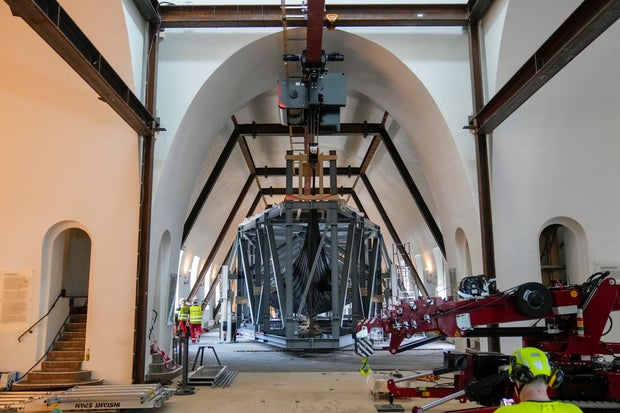3 millennia-old Viking ships embark on a final, high-risk voyage to a home

Oslo — Three 1,200-year-old Viking ships that have stood the test of time are embarking on their final and possibly riskiest journey to their new forever home in Norway. The first to make the move is the Oseberg, which will slowly inch its way from its current location in the old Viking Ship Museum to a newly built addition that will house the national treasures in optimal conditions.
The extremely fragile oak hull, encased in a heavy protective steel rig, began making the roughly hundred-yard journey on Tuesday. It was expected to take over 10 hours, with the ship lifted by a crane and moved along a track on the ceiling.
“There is something deeply moving when you think that these ships — with their long history and all the voyages they have undertaken — will embark on their final journey,” museum director Aud Tonnessen said.
In a post on its Facebook page Wednesday, the museum said the team moving the vessels “actually got a head start yesterday and covered the first 20 meters. It went perfectly according to plan.”
The museum shared a time-lapse video of the hulking Oseberg slowly moving, suspended in the air on an overhead rail system and encased in its sturdy steel frame for the journey.
Named after the places where they were discovered, the Oseberg, Gokstad and Tune — all believed to have been built between 840 and 910 — have been housed in a cross-shaped building considered too small and unsuitable to conserve them properly.
“They’ve been subjected to humidity, vibrations… Over time, the strain became so intense that they started showing signs that they would eventually collapse onto their supports,” Tonnessen said.
A decision was therefore taken to move them to a new climate-controlled facility, built as an extension to the old museum, which should make it possible to maintain the ships in their current condition for at least another century.
The relocation process is perilous.
“We have to complete this operation without causing any further damage to the ships, but we know that each handling is harmful to them,” said curator David Hauer, who has been planning the project for years.
FREDRIK VARFJELL/NTB/AFP/Getty
“These are clinker hulls (featuring partially overlapping planks) that are 1,200 years old. At the slightest deformation, they split between the rivets, the wood cracks,” Hauer explained.
Endless precautions have been taken to prevent any breakage or vibrations during the relocation. The ship will be moved extremely slowly, at a pace of 5.5 minutes per yard.
Among other things, an oil services company experienced in high-precision work — such as positioning massive structures nearly 1,000 feet below the sea with extreme accuracy — has been called in.
“But this is yet another level,” Hauer said.
“The level of precision required, for example when it comes to vibrations, is the same as for electron microscopes in hospitals” which require extreme stability, he said.
“Except here, it involves lifting the electron microscope, moving it, and then setting it back down so you can use it again,” he said.
If everything goes as planned, the Gokstad is scheduled to be relocated next during the autumn, and then finally the Tune in the summer of 2026.
FREDRIK VARFJELL/NTB/AFP/Getty
All three ships were found in separate burial sites southwest and southeast of Oslo between 1867 and 1904, each one very distinct from the other.
Richly decorated with ornate carvings, the Oseberg is considered the best preserved Viking ship in the world.
Gokstad is meanwhile the largest of the three, measuring 75 feet long and 16 feet wide, with space for 32 rowers.
Tune is much more decomposed than the other two and is believed to have been a particularly fast warship.
While Norway and its Scandinavian neighbors are often most associated with Viking-era archaeological finds, human history in the region far outdates the legendary masters of the sea.
In Denmark, coastal settlements that were engulfed by rising seas more than 8,500 years ago were charted by divers this summer. Now lying about 26 feet below the waves, close to Denmark’s second-biggest city Aarhus, there is evidence of a Stone Age settlement on the seabed.
It was discovered by divers as part of a $15.5 million, six-year project to map parts of the Baltic and North Sea floors, which is being funded by the European Union. The goal of the project is to explore sunken landscapes and uncover lost Mesolithic period settlements as offshore energy and other infrastructure projects ramp up.
3 millennia-old Viking ships embark on a final, high-risk voyage to a home
#millenniaold #Viking #ships #embark #final #highrisk #voyage #home








